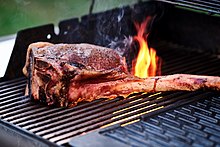Searing
Similar techniques, such as browning and blackening, are typically used to sear all sides of a particular piece of meat, fish, poultry, etc.[2] Nonetheless, it remains an essential technique in cooking meat for several reasons:[citation needed] Searing does not cause caramelization, which affects only sugars, or simple carbohydrates; the Maillard reaction involves reactions between amino acids and some sugars.It is typically mentioned for larger cuts, especially steaks and chops, of non-poultry meats such as beef, pork, lamb and tuna.Experiments to test the theory were carried out as early as the 1930s and found that the seared roasts lost the same amount of moisture or more.[7] Moisture in liquid and vapor form continues to escape from a seared piece of meat.

BeefsteakFish steakPork steakSteakhouseList of steak dishesBeef ManhattanBeef WellingtonBife a cavaloBistecca alla fiorentinaBoiled beefBulgogiCarpetbag steakCarne asadaChateaubriand steakCheesesteakChicken fried steakBistek TagalogBollito mistoDelmonico steakFajitaFinger steaksHamburg steakLondon broilMongolian beefPepper steakPot roastRoast beefItalian beefPrawn cocktail, steak and Black Forest gateauSalisbury steakSha cha beefShawarmaStanding rib roastSteak and eggsSteak and kidney pieSteak and kidney puddingSteak and oyster pieSteak au poivreSteak burgerSteak de BurgoSteak DianeSteak fritesSteak sandwichSteak tartareSuaderoSurf and turfSwiss steakCuts of beef7-boneFilletFlat ironHangerPopseyeRib eyeSilversideSirloinT-boneTenderloinTop sirloinTri-tipBarbecuedBraisedChar grilledChoppedMarinadedPickledPoachedRoastedSalt-curedSmokedList of beef dishesDonenessMeat on the boneRestructured steakSteak knifeSteak saucegrillingbakingbraisingroastingsautéingpoultryseafoodcookedbrowningblackeningMaillard reactioncaramelizationLiebigEscoffierCookingList of cooking techniquesDry roastingHot salt fryingRoasting (modern)SmokingBarbecueCharbroilerGrilling (charbroiling)Roasting (traditional)RotisserieToastingBlanchingDecoctionParboilingShockingReductionCoddlingCreamingInfusionPoachingSimmeringSlow cookingSmotheringSteepingStewingBain-marie (Double boiling)Sous-videDouble steamingSteamingBastingFryingDeep fryingPan fryingShallow fryingStir frying